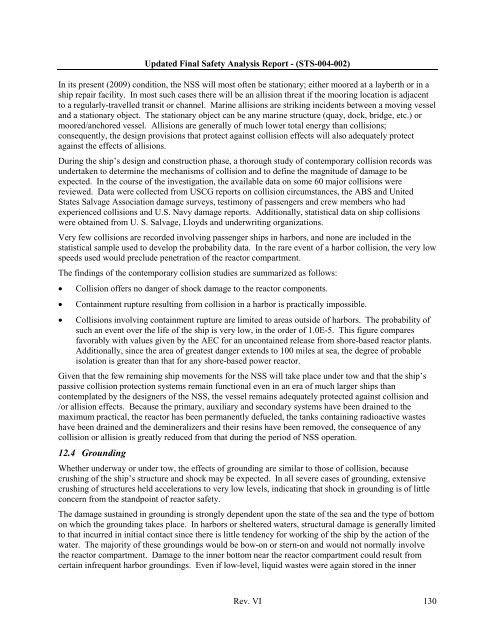10 CFR 50.71(e) - Maritime Administration - U.S. Department of ...
10 CFR 50.71(e) - Maritime Administration - U.S. Department of ...
10 CFR 50.71(e) - Maritime Administration - U.S. Department of ...
You also want an ePaper? Increase the reach of your titles
YUMPU automatically turns print PDFs into web optimized ePapers that Google loves.
Updated Final Safety Analysis Report - (STS-004-002)In its present (2009) condition, the NSS will most <strong>of</strong>ten be stationary; either moored at a layberth or in aship repair facility. In most such cases there will be an allision threat if the mooring location is adjacentto a regularly-travelled transit or channel. Marine allisions are striking incidents between a moving vesseland a stationary object. The stationary object can be any marine structure (quay, dock, bridge, etc.) ormoored/anchored vessel. Allisions are generally <strong>of</strong> much lower total energy than collisions;consequently, the design provisions that protect against collision effects will also adequately protectagainst the effects <strong>of</strong> allisions.During the ship’s design and construction phase, a thorough study <strong>of</strong> contemporary collision records wasundertaken to determine the mechanisms <strong>of</strong> collision and to define the magnitude <strong>of</strong> damage to beexpected. In the course <strong>of</strong> the investigation, the available data on some 60 major collisions werereviewed. Data were collected from USCG reports on collision circumstances, the ABS and UnitedStates Salvage Association damage surveys, testimony <strong>of</strong> passengers and crew members who hadexperienced collisions and U.S. Navy damage reports. Additionally, statistical data on ship collisionswere obtained from U. S. Salvage, Lloyds and underwriting organizations.Very few collisions are recorded involving passenger ships in harbors, and none are included in thestatistical sample used to develop the probability data. In the rare event <strong>of</strong> a harbor collision, the very lowspeeds used would preclude penetration <strong>of</strong> the reactor compartment.The findings <strong>of</strong> the contemporary collision studies are summarized as follows:Collision <strong>of</strong>fers no danger <strong>of</strong> shock damage to the reactor components.Containment rupture resulting from collision in a harbor is practically impossible.Collisions involving containment rupture are limited to areas outside <strong>of</strong> harbors. The probability <strong>of</strong>such an event over the life <strong>of</strong> the ship is very low, in the order <strong>of</strong> 1.0E-5. This figure comparesfavorably with values given by the AEC for an uncontained release from shore-based reactor plants.Additionally, since the area <strong>of</strong> greatest danger extends to <strong>10</strong>0 miles at sea, the degree <strong>of</strong> probableisolation is greater than that for any shore-based power reactor.Given that the few remaining ship movements for the NSS will take place under tow and that the ship’spassive collision protection systems remain functional even in an era <strong>of</strong> much larger ships thancontemplated by the designers <strong>of</strong> the NSS, the vessel remains adequately protected against collision and/or allision effects. Because the primary, auxiliary and secondary systems have been drained to themaximum practical, the reactor has been permanently defueled, the tanks containing radioactive wasteshave been drained and the demineralizers and their resins have been removed, the consequence <strong>of</strong> anycollision or allision is greatly reduced from that during the period <strong>of</strong> NSS operation.12.4 GroundingWhether underway or under tow, the effects <strong>of</strong> grounding are similar to those <strong>of</strong> collision, becausecrushing <strong>of</strong> the ship’s structure and shock may be expected. In all severe cases <strong>of</strong> grounding, extensivecrushing <strong>of</strong> structures held accelerations to very low levels, indicating that shock in grounding is <strong>of</strong> littleconcern from the standpoint <strong>of</strong> reactor safety.The damage sustained in grounding is strongly dependent upon the state <strong>of</strong> the sea and the type <strong>of</strong> bottomon which the grounding takes place. In harbors or sheltered waters, structural damage is generally limitedto that incurred in initial contact since there is little tendency for working <strong>of</strong> the ship by the action <strong>of</strong> thewater. The majority <strong>of</strong> these groundings would be bow-on or stern-on and would not normally involvethe reactor compartment. Damage to the inner bottom near the reactor compartment could result fromcertain infrequent harbor groundings. Even if low-level, liquid wastes were again stored in the innerRev. VI 130
















